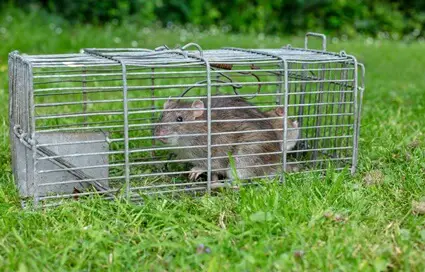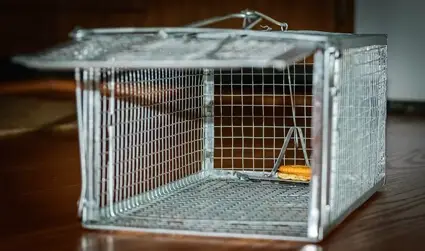You don’t have to use deadly, inhumane ways to get rid of rats. After all, some of these methods put the health of humans and family pets at risk. The good news is that you can catch rats humanely.
You can get rid of rats without killing them with catch and release rat traps, baiting them with peanut butter. Alternatively, apply strong scents like peppermint oil to repel them.
Ultrasonic repellent devices can drive rats away, as can commercial repellents like Varpel Rope.
If you want to deter rats from your home, maintain good sanitation and eliminate access to food. You can seal gaps and openings to make it harder for rats to gain entrance.
How Do I Get Rid Of Rats Without Killing Them?
In most countries, it is legally acceptable to kill wild rats as a pest control method.
However, some jurisdictions in the U.S., such as Washington D.C., have strict rat control laws. These rules require that we capture and release rats into the wild without killing them.
Some countries in Europe have banned the sale of rat poison to individuals other than pest control experts. This means you need an alternative method of getting rid of rats other than killing them.
You can get rid of rats from your home or business without killing them in the following ways:
Commercial Repellents
According to the University of Nebraska, various experiments determined that commercial repellents like Varpel Rope keep rats and other rodents away.
Varpel Rope consists of active compounds similar to mothballs. The compounds deter rats from entering your home without killing them.
You have to tie the rope along paths that rats frequent. You can also cut the rope into pieces and place them near food and water sources to keep rats away.
Commercial repellents are a temporary solution, losing lose their potency over time.

Ultrasonic Repellents
Ultrasonic repellents are small gadgets that emit high-pitched sounds that make rats uncomfortable.
They work because rats dislike disturbances from light and noise. So, using ultrasonic repellents effectively drives rats out of your home without killing them.
Rats have good hearing and often use high-pitched sounds to communicate with each other. So, a piercing ultrasonic noise will make them feel uncomfortable.
The rats will go in the other direction, while you and most pets will be unable to hear the sound.
Humans and many animals hear in a range of from 20 Hz to 20 kHz. Devices like ultrasonic repellents emit noises within a rat’s 200 Hz to 76 kHz hearing range.
You only need to place the gadget near rats’ nesting sites. Unlike setting up traps or using poison, ultrasonic repellents are safe for non-targeted wildlife and won’t harm children.
Natural Deterrents
There’s a wide range of scent repellents that get rid of rats without killing them, including:
- Cloves
- Black pepper
- Cayenne pepper
- Eucalyptus
- Citronella
- Peppermint
The main advantage of using these deterrents is they’re harmless to humans and pets. At the same time, the strong scent can dissuade rats from entering your home.
Just apply these essential oils in entry points and near places that rats frequent.
However, rats are adaptable creatures. At first, they may avoid the scent, but once they realize it’s non-harmful, they may learn to ignore the deterrent.
Catch And Release Traps
Glue traps, electric traps, and snap traps are designed to kill rats instead of capturing them for safe release later. Instead, you can use catch and release traps (live traps).
Live traps capture and retain rats until you decide to release them in the wild.
How To Get Rid Of Rats Without Poison
Many homeowners opt to use poison as a way of removing rats.
However, rat poison isn’t just a cruel way of getting rid of rats, it’s also a short-term solution since not all rats will eat poisoned bait.
According to Carbohydrate Research, poison shyness can encourage rats to avoid new food and refuse to consume bait in the future.
Also, rat poison poses risks to your household. According to Scientific Total Environment, rat poison can cause secondary poisoning.
You can get rid of rats without poison by doing the following:
Organized Home
Rats favor homes where they can find food, water, and shelter without difficulty.
For instance, if you leave the dishes unwashed or the floors unmopped after spilling food or drinks, rats are likely to enter your home, viewing these as good food sources.
Rats favor the following conditions:
- Overflowing trash cans
- Piles of leaves in the yard
- Stacks of dirt clothes
- Cluttered storage items
- Unsecured compost heaps
If you clean up regularly, rats won’t find the situation favorable.
Eliminate Access To Food
Rats are opportunistic scavengers, and they come to our homes in search of food and water. You can restrict food access by storing food, including leftovers, appropriately.
Keep food in airtight metal or glass containers to prevent them from accessing it. Your pantry should be best secured with metal sheeting and other hard-to-chew materials.

Seal Gaps And Openings
Rats are agile and flexible, making it easy to pass through the tiniest holes and spaces.
Sealing entry points and gaps goes a long way toward keeping rats out. Rats may attempt to chew new holes where they can, but you can seal any additional openings.
Are Catch And Release Rat Traps Efficient?
Catch and release rat traps enable you to get rid of rats in your home or office without killing them, so they can be released later.
You can purchase catch and release traps online, in general stores, or at hardware stores. However, if you want to save on costs, you can make your own.
How To Make A Catch And Release Rat Trap
Here are the steps to make a DIY catch and release rat trap:
- Get a tall, thin bottle or container (glass is ideal, and it should be more than 36 inches tall).
- Ensure the top of the bottle is large enough for a rat to enter.
- Secure the bottom on cardboard using duct tape. You can place large rocks on the cardboard to prevent the bottle from tipping over.
- Place rocks or a ramp nearby so that rats can gain access to the bottle.
- Grease the inside of the bottle with oil.
- Place a treat, like cheese or peanut butter, inside the bottle to act as bait.
- Once the rat is inside the bottle, it won’t be able to climb out, as the bottle is slippery and too tall.
- Take the captured rat away and release it far away from populated areas.
Is It Illegal To Release Trapped Rats?
While capturing and relocating wildlife is illegal in most jurisdictions, releasing trapped rats isn’t forbidden. Rats are considered pests.
So, you’re allowed to release them a minimum of 2-3 miles away from your home. Also, ensure that rats aren’t released anywhere near residential properties.








